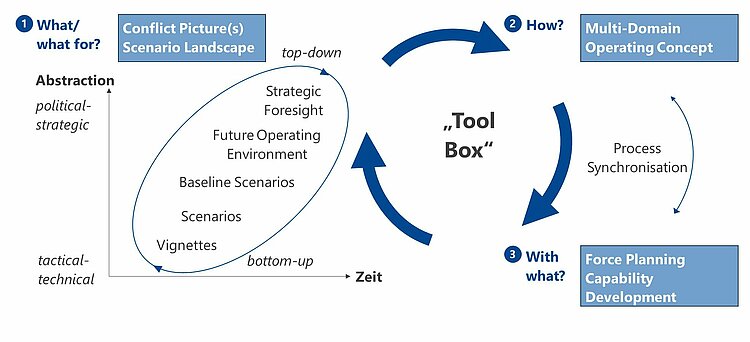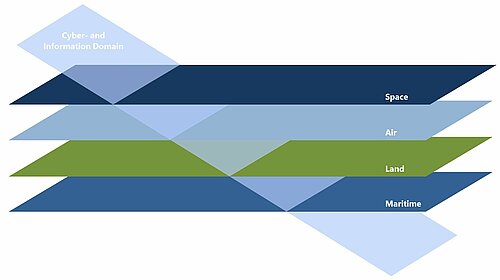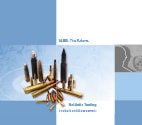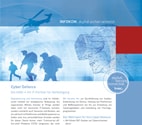The term Multi-Domain Operations (MDO) has been increasingly used for several years to describe the current and future challenges in warfare and to give a name to the necessary orientation of modern armed forces of the future.
The requirement to be able to plan and execute MDO requires cross-domain and command-level consistent capabilities and procedures. The tasks of national and alliance defence as well as the operational effects of innovative, sometimes disruptive technologies pose overall planning challenges for strategic management in the Federal Ministry of Defence and the German Armed Forces (Bundeswehr) with new capability development requirements for the coming decades.
The Bundeswehr has already developed promising and usable approaches. For the design of MDO capabilities, these approaches should be brought together, made applicable and reusable for capability management, supplemented by substantial innovative and multi-value approaches and transferred synergistically for use. A combined top-down and bottom-up approach is promising.
The following questions must be answered:
![[Translate to English:] Führung [Translate to English:] Führung](/fileadmin/_processed_/a/5/csm_Entscheidung_5251d6e093.png)
What overall planning concepts and standards result from the MDO understanding, for example with regard to requirements for command and decision-making processes, integrated planning, procurement and armaments as well as for cyber and IT portfolio management?
![[Translate to English:] Konzeption [Translate to English:] Konzeption](/fileadmin/_processed_/b/8/csm_Kopfdenkt_a543e9f27c.png)
Which overall planning concepts and standards are to be recorded and pursued conceptually and doctrinally for operational and deployment planning and management?
![[Translate to English:] Anforderungen [Translate to English:] Anforderungen](/fileadmin/_processed_/0/b/csm_System_a9e461237e.png)
What overarching requirements for capability development and in particular for technical systems, e.g. cloud applications, as enablers are derived from this?
A Scenario Landscape as a Common Starting Point
A scenario landscape derived from future analysis - from strategic foresight to the future operational environment to tactical vignettes - can create a common understanding of the problem space and the respective object of consideration for the objectives of capability development between different actors.
Given a scenario-based background, the questions of purpose ("What for?") and the specific tasks ("What?") must be answered across all stakeholder levels and between those involved from different disciplines (operators, planners, enablers, etc.), and the associated procedural and technical derivations must be made ("How?").
The respective requirements (functional, non-functional, technical, etc.) for capabilities can be brought together along these identified MDO needs. To this end, planning, procurement and armaments and, above all, the forces in their value chain must be coordinated and synchronized. Tailored to the operational context and new deployment procedures, the prerequisites for the interaction of existing and future systems, such as Combat Cloud and Cloud-of-Clouds, are created ("With what?"). The triad of (1) What for/What? (2) How? and (3) With what? corresponds to the German conceptual understanding of capability.
The Cyber- and Information Domain as a Key Feature of MDO
In recent decades, space and cyber and information domain (CID, comparable to the Information Environment in accordance with NATO’s definition) have been added as military spheres of action and operational domains. Even if conceptual documents state that these are "equivalent", there are still differences. The CID is man-made and permeates the other dimensions more than any other domain.
The CID is not a dimension "alongside the others", but a cross-cutting domain that permeates all other domains and on which the other domains depend to a special degree. The CID is possibly the most important innovation that requires a rethink in operational thinking and is the permanent link between all other dimensions. This is not just about "the internet" as we know it today, but also about the (military) internet of things (MIoT) with its new possibilities and vulnerabilities. Germany and its armed forces are attacked and defended within the CID on a daily basis. Threats in this area are constantly growing and will foreseeably only be overcome in cooperation with civilian actors and partners from other nations (keyword: European IT infrastructure and digital sovereignty). MDO as a solution approach must take into account and cover the special features of the "new" operational domains of CID and Space.
National Secure Cloud - model-based, flexibel and resilient
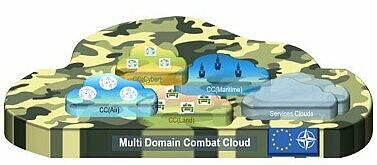
A role-appropriate situational awareness is achieved by analysing the information provided by all parties involved: ideally, the information is provided without delay and in compliance with different security classifications. A controlled and protected exchange of data between networks and systems and with different security classifications is therefore essential. This can be realised through a multi-cloud approach.
The Bundeswehr sees the Multi-Domain Combat Cloud (MDCC) as the technical basis for establishing information, command and control and effectiveness superiority. It forms the core part of the Core, Fog, Edge cloud system and is particularly suitable for complex planning processes, collaboration, data analysis and the use of ML and AI algorithms. The MDCC also consists of dimension-specific Combat Clouds (CC) and the weapon systems with sensors and effectors in the Edge. CCs are collaboration environments adapted to the operation, which network platforms, facilities, people, etc. and take into account the respective framework conditions of the operation. Consequently, the aim of the MDCC is, among other things, the resilient networking of all relevant sensors and effectors (edge) to enable the management of multi-domain operations (MDO). The overall system must be organised as a uniform architecture. Cyber security and resilience are fully integrated and categorisation even higher than VS-NfD is manageable.
With regard to NATO, MDCC also means resource-saving security regarding the connection of other nations in deployment scenarios (NATO FMN), the connection of civilian forces (e.g. BND) and the connection to soldiers in combat.
With the National Secure Cloud, we are meeting these challenges and developing an authorisable, highly mobile, sovereign, private cloud solution for data processing up to SECRET.

Reference architecture and cloud technology stack for infrastructure operators and private cloud operators

Several security domains as a service up to SECRET on one hardware for the first time
![[Translate to English:] IaaS, PaaS, SaaS IaaS, PaaS, SaaS](/fileadmin/_processed_/1/7/csm_Bild8_0901b222c0.png)
Modular and interoperable solutions (IaaS, PaaS, SaaS)

Digital, sovereign, evaluable
![[Translate to English:] Contact](/fileadmin/_processed_/8/f/csm_Bild3_56029a7b70.png)
Do you have any questions? Please contact us.
Defence & Security
info-defence@iabg.de
+49 89 6088-3016
- VDA ISA TISAX zertifiziert für die Labels „Informationen mit sehr hohem Schutzbedarf“, „Prototypenschutz“ und „Datenschutz“ für die Standorte Ottobrunn und Lichtenau
- ISO 45001 (Locations Ottobrunn, Lichtenau)
- ISO 14001
- DIN EN ISO/IEC 17025 (Location Lichtenau)
- Verzeichnis der Prüfverfahren – Prüflaboratorium DIN EN ISO/IEC 17025 (Standort Lichtenau)
- ISO 9001
- EN 9100
